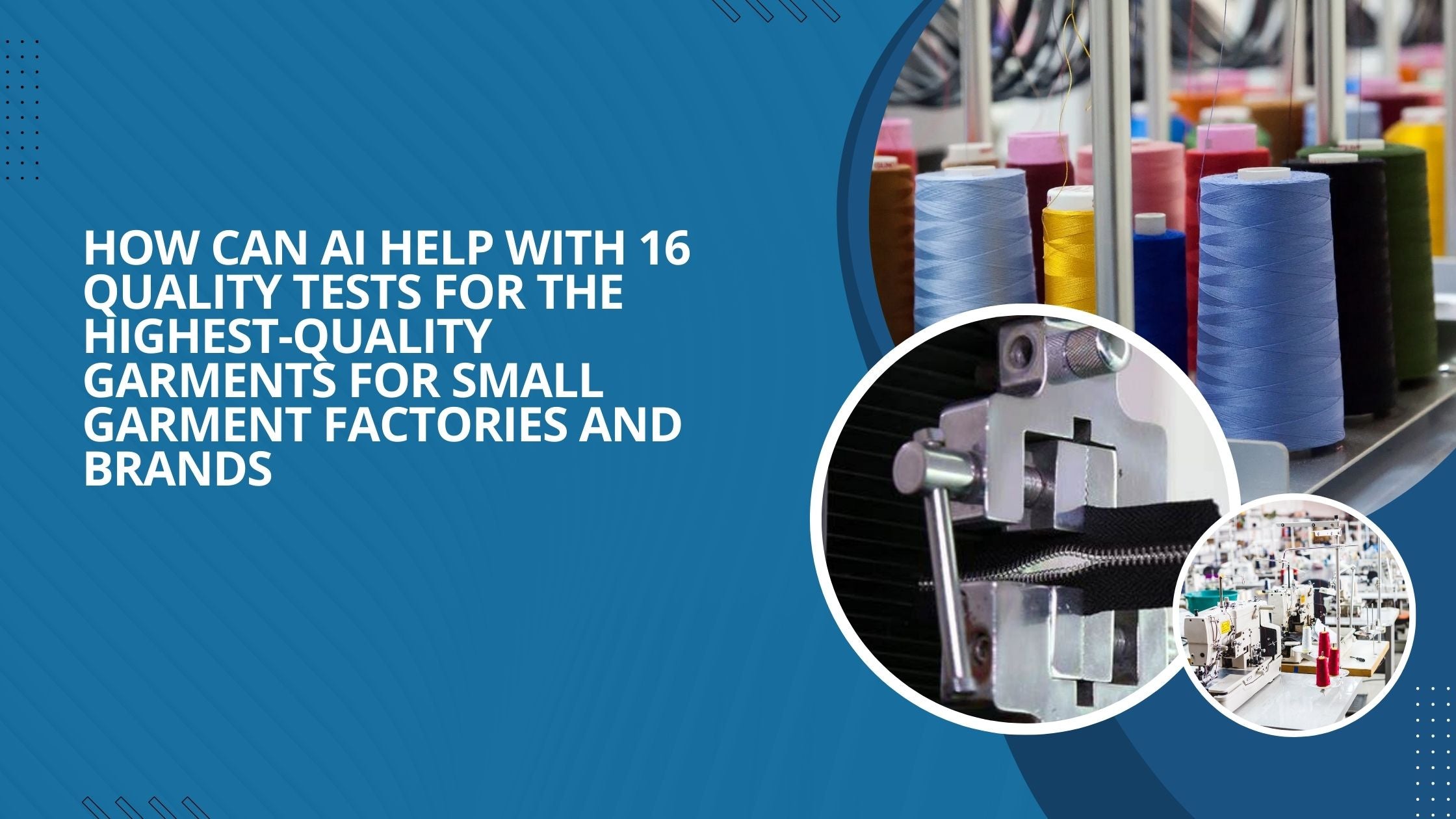How Can AI Help with 16 Quality Tests for the Highest-Quality Garments for Small Garment Factories and Brands
| Dec, 07 , 24
In today's competitive global market, the success of garment brands hinges on delivering high-quality products that meet consumer expectations. Quality control is vital for customer satisfaction, brand reputation, and overall business success. Conventional quality control techniques depend largely on manual inspections, making them time-consuming and prone to inaccuracies. However, the advent of artificial intelligence (AI) offers innovative solutions to revolutionize quality control processes in the garment manufacturing industry.
We will explore leveraging AI to enhance quality control in small garment factories, improve efficiency, reduce costs, and ensure that products meet the highest standards. By understanding the potential of AI, small garment factories can gain a competitive edge and deliver exceptional quality to their customers.

AI-Powered Material Testing: Revolutionizing Garment Manufacturing
Material testing is a critical aspect of garment manufacturing, ensuring that the fabrics used meet the required quality, durability, and performance. Conventional methods for testing materials often require substantial time and effort. However, the integration of artificial intelligence (AI) has the potential to revolutionize this process, offering greater efficiency, accuracy, and consistency.
Fabric Testing
- Traditional Methods: Fabric testing typically involves manual methods, like tensile testing machines and colorfastness tests. Traditional quality control methods are a bottleneck in the production process.
- AI-Powered Solutions: AI-powered image analysis and machine learning algorithms can automate fabric testing processes. For example, AI can analyze images of fabric samples to assess properties like strength, colorfastness, and shrinkage. Automated testing systems provide consistent and reliable results.
Fiber Testing
- Traditional Methods: Fiber testing often involves chemical analysis or microscopic examination. These techniques often involve complexity and demand specialized knowledge.
- AI-Powered Solutions: AI can analyze fiber images to determine their quality and characteristics. AI-powered image analysis algorithms can quickly and accurately classify fibers based on their unique characteristics.
Thread Testing
- Traditional Methods: Thread testing typically involves tensile testing machines to measure strength and elasticity. They also conduct colorfastness tests manually.
- AI-Powered Solutions: AI can automate thread testing processes. For example, AI-powered vision systems can analyze images of threads to assess their strength, elasticity, and colorfastness. AI-powered testing can increase accuracy and reduce the reliance on manual labor.

AI-Powered Garment Construction Testing: A Revolution in Quality Control
Proper construction techniques are vital for garment quality. Traditional quality control is time-consuming and error-prone. However, the integration of artificial intelligence (AI) has the potential to revolutionize this process, offering greater efficiency, accuracy, and consistency.
Seam Strength Testing
- Traditional Methods: Seam strength testing typically involves manual methods, such as pulling on seams to assess their strength. It can be subjective and time-consuming.
- AI-Powered Solutions: AI-powered vision systems can automate seam strength testing by analyzing images of seams and identifying potential defects, such as loose threads or weak stitches. These systems can provide objective and quantitative measurements of seam strength.
Dimensional Stability Testing
- Traditional Methods: Dimensional stability testing often involves manual measurements of garments before and after washing and drying. Human error can lead to inconsistencies in quality control.
- AI-Powered Solutions: AI-powered image analysis can automate dimensional stability testing by comparing images of garments before and after processing. It can provide accurate measurements of shrinkage or stretching and identify potential issues with the garment's construction.
Garment Fit Testing
- Traditional Methods: Garment fit testing typically involves garments on human models and assessing their comfort and appearance. It can be time-consuming and subjective.
- AI-Powered Solutions: AI-powered body scanning technology can create digital avatars of different body types, allowing for the virtual fitting of garments. This can help detect potential fit problems before the garment is fully developed.
Zipper and Button Testing
- Traditional Methods: Zipper and button testing typically involves manual inspection and testing for functionality and durability. Manual quality checks are inefficient.
- AI-Powered Solutions: AI-powered vision systems can automate zipper and button testing by analyzing images of garments and identifying defects, such as broken zippers or loose buttons. It can improve accuracy and efficiency.

AI-Powered Appearance and Finish Testing: Elevating Garment Quality
Appearance and finish are crucial aspects of garment quality, significantly impacting consumer satisfaction and brand perception. Traditional testing methods rely on human judgment, which can be inconsistent. However, artificial intelligence (AI) offers innovative solutions to revolutionize these processes, enhancing efficiency, accuracy, and consistency.
Colorfastness Testing
- Traditional Methods: Colorfastness testing typically involves exposing fabric samples to various conditions, such as light, water, and sweat. It measures their capacity to withstand fading or color transfer. This process can be time-consuming and labor-intensive.
- AI-Powered Solutions: AI-powered image analysis can automate colorfastness testing by analyzing images of fabric samples before and after exposure to different conditions. It allows for objective and quantitative measurements of colorfastness, reducing the subjectivity of manual testing.
Wrinkle Resistance Testing
- Traditional Methods: Wrinkle resistance testing often involves manually assessing the appearance of garments after they have been crumpled or washed. It can be subjective and time-consuming.
- AI-Powered Solutions: AI-powered image analysis can automate wrinkle resistance testing by analyzing images of garments and objectively measuring the severity of wrinkles. It can provide more consistent and accurate results compared to manual assessment.
Surface Appearance Testing
- Traditional Methods: Surface appearance testing typically involves visual inspection by human experts, and can be subjective and prone to human error.
- AI-Powered Solutions: AI-powered vision systems can automate surface appearance testing by analyzing images of garments and identifying defects such as uneven stitching, pilling, or fabric flaws. It can improve accuracy and consistency, ensuring that only apparel with the highest quality standards reaches customers.

AI-Powered Functional Testing: Enhancing Garment Performance
This testing ensures that garments meet specific performance requirements, such as comfort, durability, and weather resistance. Conventional testing methods often require significant time and are susceptible to mistakes due to human involvement. However, artificial intelligence (AI) offers innovative solutions to revolutionize functional testing processes, improving efficiency, accuracy, and consistency.
Water Resistance Testing
- Traditional Methods: Water resistance testing often involves manually exposing garments to water and assessing their ability to repel moisture. It can be subjective and time-consuming.
- AI-Powered Solutions: AI-powered image analysis and sensor technology can automate water resistance testing. For example, AI can analyze images of garments exposed to water to measure the extent of water penetration. Additionally, sensors can be integrated into garments to measure moisture levels and provide real-time data on water resistance.
Breathability Testing
- Traditional Methods: Breathability testing typically involves measuring the moisture vapor transmission through the fabric. The process can be intricate and take a considerable amount of time.
- AI-Powered Solutions: AI-powered sensors and data analysis can automate breathability testing by measuring moisture levels and airflow through the fabric. It can provide accurate and consistent results, helping to identify garments with optimal breathability properties.
UV Protection Testing
- Traditional Methods: UV protection testing typically employs UV meters to determine the level of UV radiation that can pass through the fabric. It can be a labor-intensive process.
- AI-Powered Solutions: AI-powered sensors and data analysis can automate UV protection testing by measuring the amount of UV radiation that passes through the fabric. It can provide accurate and consistent results, helping to ensure that garments offer adequate protection against harmful UV rays.

AI-Powered Safety and Regulatory Compliance Testing: Ensuring Garment Quality and Consumer Protection
Ensuring safety and adhering to regulatory standards are of utmost importance in the garment manufacturing industry. Traditional testing methods can be time-consuming and labor-intensive, while AI offers innovative solutions to streamline these processes, improve accuracy, and ensure product safety.
Chemical Testing
- Traditional Methods: Chemical testing typically involves sending samples to laboratories for analysis. It can be time-consuming and expensive.
- AI-Powered Solutions: AI-powered sensors and spectroscopy techniques can analyze garments for the presence of harmful chemicals. These methods offer faster, more efficient, and cost-effective testing than traditional laboratory methods.
Flammability Testing
- Traditional Methods: Flammability testing often involves manually igniting fabric samples and measuring their flammability characteristics. It can be dangerous and time-consuming.
- AI-Powered Solutions: AI-powered image analysis and sensor technology can automate flammability testing by analyzing images of burning fabric samples and measuring flame spread, heat release, and other relevant parameters. It can provide more accurate and consistent results compared to manual testing.
Labeling and Packaging Testing
- Traditional Methods: Labeling and packaging testing typically involves manual inspection to ensure compliance with regulatory requirements. The process can take a considerable time and is susceptible to human mistakes.
- AI-Powered Solutions: AI-powered vision systems can automate labeling and packaging testing by verifying the accuracy of labels, checking for missing or incorrect information, and inspecting packaging for defects. It can enhance efficiency and precision while minimizing the risk of non-compliance.

Partner with EverLighten for Cutting-Edge AI Solutions in Garment Manufacturing
So there you have it. We've discussed the 16 quality tests that can help small garment factories and brands ensure the highest quality products. You can significantly improve your product quality, customer satisfaction, and brand reputation.
Remember, AI can be a powerful tool to streamline and enhance the quality control process. By leveraging AI-powered solutions, you can automate many of these tests, reduce human error, and gain valuable insights into your production processes.
Ready to transform your garment manufacturing with AI? EverLighten offers a comprehensive range of AI-powered solutions to streamline your operations, improve quality, and gain a competitive edge.
Why Choose EverLighten?
- 100% Customization: Tailored garment solutions to your specific needs and goals.
- 100% Quality Assurance: Ensure the highest level of quality and accuracy in your garment processes.
- Free Design Help: Our experts will assist you in designing, fabric choosing, shipping, etc.
- Worldwide Delivery: Access our services from anywhere in the world.
- 24/7 Support: Our dedicated team is always available to address your questions and provide assistance.
- Unlimited Revisions: You can revise your garments until you are 100% content with them.
- Low MOQ: Benefit from flexible pricing options to suit your business needs.
Contact EverLighten today to revolutionize your garment brand!
FAQs
What types of solutions do you offer for garment manufacturing?
We offer many solutions, including AI-powered quality control systems, design, shipping, etc.
How can AI help improve efficiency and productivity in my garment factory?
AI can automate time-consuming tasks, optimize production processes, and reduce waste. It increases efficiency and productivity.
What are the costs associated with implementing AI solutions in my garment factory?
The cost of implementing AI can fluctuate based on the particular solutions selected and the scale of your factory.
How quickly can results be observed after implementing AI?
The time to see results from AI implementation can vary depending on the specific solutions and your business goals. However, many garment factories experience significant improvements within a short period.
Do I need to have prior experience with AI to use your solutions? No. Experts can help you understand and implement AI solutions, even if you have no previous experience.

